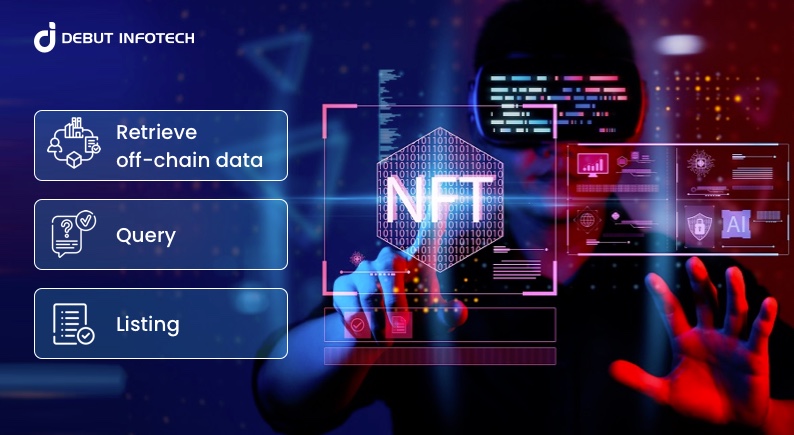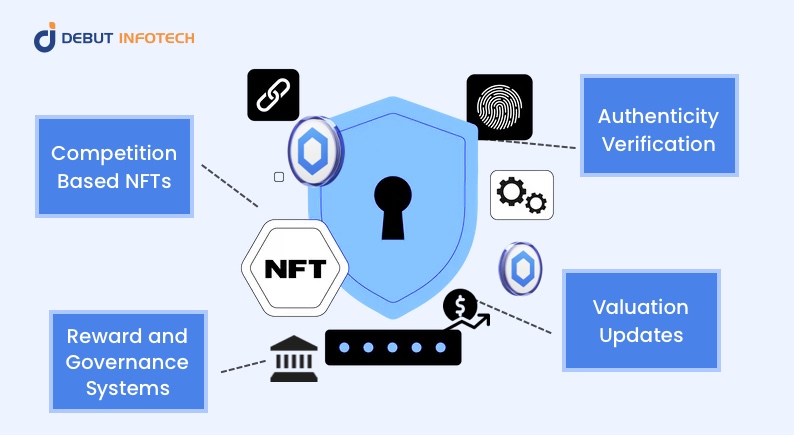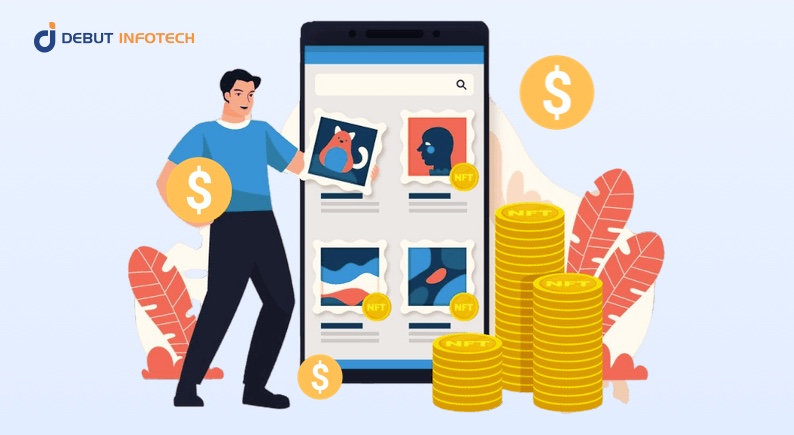Table of Contents
Home / Blog / NFT Marketplace
How to Create Dynamic NFTs Using Chainlink Oracles?
January 25, 2024

January 25, 2024
NFT trading is one of the newest online trends. In addition, you may be interested in learning how to generate NFTs if you are planning to trade NFTs or are already doing so. This insight will review how to use the Chainlink Oracle to construct NFTs. Did you know there are sixteen ways to use Chainlink oracles to create Non-Fungible Tokens (NFT)? Perhaps most importantly, Chainlink oracles enable the generation of dynamic NFTs, which is considered the next step up from static NFTs.
This article will thoroughly discuss the application cases for dynamic NFTS and the function of Chainlink oracles. However, let us begin by outlining the ideas behind NFTs and Chainlink oracles.
What Are Chainlink Oracles?
Although blockchain technology is revolutionary, it has a drawback affecting NFTs. Since Blockchain is static, it can only interact with data stored on the chain. The utility of Blockchain as a solution to real-world problems is severely limited by its inability to interact with real-world data systems and sources.
The decentralized oracle network (DON) of Chainlink is crucial in addressing this connection issue. Blockchain smart contracts can securely and dependablely connect to external systems and data sources via Chainlink oracles. It makes it possible for Blockchain to communicate with off-chain data in the real world.
Now that we understand what Chainlink Oracles are let’s talk about what Dynamic NFTs are.
What Are Dynamic NFTs?
Despite being driven by blockchains, NFTs remain static since they are exclusive to the blockchain ecosystem. However, NFTs built with the Chainlink Oracle are no longer static. Chainlink-powered NFTs are dynamic because they can link to off-chain data sources, including web APIs, IoT data, and other providers. Dynamic NFTs are far more applicable and practical because of their capacity to interface with real-world data sources.
Additionally, dynamic NFTs can access verified randomness, trigger cyber-physical systems, and integrate with current backend systems by utilizing Chainlink VRF.
Personalized Interactions: Dynamic NFTs can be configured to alter according to the owner’s choices, including location, time of day, and NFT engagement. For NFT owners, this may enable a more engaging and customized experience.
Art evolution: Dynamic NFTs can be programmed to adapt over time by introducing new features or changing the artwork’s nature. As a result, the artwork could become more dynamic and fascinating and vary depending on how the owner engages with it.
Interactive games: A dynamic NFT can be used to make interactive games where players can compete with one another or upgrade their NFTs. This might create new opportunities for blockchain gaming.
Examples of Dynamic NFTs
Here are a few of the most outstanding real-world dynamic NFT examples going viral!
LaMelo Ball NFTs: These are based on the stats of NBA player LaMelo Ball and track his success. For instance, if Ball records a triple-double, the NFT will adjust to account for that accomplishment.
NBA Top Shot: This platform allows Users to exchange and collect dynamic NFTs of NBA highlights. The NFTs are dynamic; for example, they gain value if the player makes a shot that wins the game. These changes are dependent on the player’s actual performance.
Gods Unchained: Dynamic NFTs are used in this blockchain-based trading card game. Players can get a competitive edge by upgrading their NFTs over time.
The Sandbox: It is a virtual environment where people can produce and possess digital content. These resources may be dynamic NFTs, which allow them to alter over time in response to user activity.
Async Art: Using this platform, artists can produce dynamic NFTs subject to updates and changes over time. This enables artists to create more participatory and captivating pieces of art.
Cryptokitties: One of the first and most well-known NFT initiatives is CryptoKitties. These are virtual cats that are exchangeable, breedable, and collectible. The colour and pattern of the cats’ fur are among their many characteristics that are subject to change.
What Are The Benefits of Dynamic NFTs
Comparing dynamic NFTs to static NFTs reveals several possible advantages. They may be used for various use cases and are more interactive, safe, and engaging. Some of the benefits are:
1. Enhanced communication
For example, it is possible to program dynamic NFTs to react to human input by altering their look or behaviour. Because of this, they may be more interactive and exciting than static NFTs, which are just digital copies of fixed assets.
2. Innovative use cases
Many new use cases that were not feasible with static NFTs can be addressed with dynamic NFTs. They might be used, for instance, to make in-game items that change as the player advances or tickets that dynamically alter to represent the status of an event.
3. Enhanced security.
It is possible to program security measures into dynamic NFTs to make them harder to counterfeit. They might be configured, for instance, to have a unique number that is altered each time the NFT is moved.
4. Greater transparency
Programing a dynamic NFT to trace their provenance and ownership is possible. This could increase market transparency for NFTs and facilitate the detection of fake NFTs.
How To Create Dynamic NFTs Using Chainlink Oracles

- Retrieve off-chain data
The first step is to use the Chainlink oracles in your NFT smart contracts to retrieve off-chain data. There are three steps to doing this:
Chainlink price feeds: It gets your smart contracts’ most recent asset prices from sources.
Chainlink VRF: It makes your smart contracts less random.
Chainlink Contract Collection: You can request and get data from any API right here.
For example, Chainlink Price Feeds will retrieve and compile off-chain data from several premium data aggregators and then send it to the BSC network if you are minting NFTs in Binance Smart Chain.
- Query
Once the off-chain data is on-chain, you can query the data feed from your smart contracts, and depending on the values provided by Chainlink oracles, you can modify the NFT assets and proceed with the minting.
- Listing
Once minting is done, you can list the dynamic NFTs in the NFT marketplace platform for selling.
Uses cases of dynamic NFTs

Currently, there are around 16 use cases accessible to developers to create dynamic NFTs using Chainlink Oracle. These NFT use cases can be categorized into the following four categories:
1. Competition Based NFTs
- Game Performance
Using off-chain data by chainlink oracles to generate NFTs depending on player performance is common for NFTs in-game items. This can resolve contest results by assigning ownership per performance, for example, awarding a unique sword to the victor.
- Verifiable Randomness
To guarantee the placement, creation, and distribution of in-game objects, Chainlink VRF gives random features to NFTs. This allows it to determine NFTs’ rarity and power ranking based on their impartial unpredictability.
- Augmented Reality
Pokemon GO demonstrated how video games can spark international tournaments. With NFTs, chainlink oracles can generate analogous experiences by minting them in physical locations based on objective or subjective user data.
- Real-Life Fantasy Sports
The Chainlink Oracle can mint NFTs that represent actual sports players to facilitate fantasy sports games. The player’s actual statistical results determine these NFTs’ worth. Chainlink oracles can transparently identify winners, calculate NFT values, and initiate payouts.
2. Reward and Governance Systems
Chainlink Oracle-based dynamic NFTs can encourage customer behaviour by integrating data from multiple sources, including Fitbit band data, into an NFT smart contract. The technique can be applied to real-world lifestyle data to determine whether users receive the NFT. Chainlink can also employ NFTs instead of paper or digital coupons for event-based prizes to ensure accurate and equitable reward distribution.
3. Authenticity Verification
By merging NFT mining with current systems, Chainlink Oracle can transform the field, especially when tracking unique real-world assets. Through the Blockchain, NFTs can confirm the provenance of goods, improving quality control and reducing counterfeiting. By minting credentials as immutable NFTs on the Blockchain, Chainlink oracles can also help with certification verification.
4. Valuation Updates
Dynamic NFTs are necessary for regular adjustments to the valuation. Dynamic NFTs can access external data sources through Chainlink Oracles Gateways, which guarantees accurate assessments for on-chain assets such as real estate, agricultural land, and tangible commodities. Oracles also provide GPS locations for assets.
How Much Does it Cost to Develop Dynamic NFTs?

Here is a more detailed breakdown of the factors that can affect the NFT marketplace development cost and the cost of developing dynamic NFTs:
Complexity of the NFT: The complexity of the NFT is one of the most significant factors affecting the cost. If the NFT is simple, such as a ticket that changes its appearance to reflect the artist’s current setlist, then the price will be relatively low. However, if the NFT is more complex, such as a sword in a video game that increases in power as the player defeats more enemies, then the cost will be higher.
Features of the NFT: The features of the NFT will also affect the cost. For example, the price will be higher if the NFT stores or updates a lot of data frequently.
Blockchain platform: The blockchain platform used to create the NFT will also affect the cost. Some blockchain platforms, such as Ethereum, are more expensive than others.
Developer’s fees: The fees charged by the developer will also affect the cost. Some developers charge more than others, so it is essential to shop around.
How Debut Infotech Can Help You With Creating Dynamic NFTs
As a blockchain development company, Debut Infotech offer solutions and services for NFT marketplace development, wallet construction, node building, blockchain consulting, maintenance, upgrades, smart contracts, and dApp development. In addition to taking on projects on demand, we provide quick-to-deploy custom solutions. We offer all-inclusive NFT services, and we can assist you in designing and constructing smart contracts for your NFTs and NFT creation for your digital assets.
Frequently Asked Questions
Q. How do chainlink oracles work?
A. Chainlink is an extension of blockchain functionality that makes smart contracts more robust against tampering and more dependable by tying them to real-world data, events, payments, and off-chain computation through secure oracles.
Q. Why are blockchain oracles interested?
A. They are the framework for establishing connections between your smart contracts and the outside world, enabling communication across blockchains. Smart contracts without oracles can only handle data already on the chain; they cannot access vital information such as price feeds, live events, or web APIs.
Q. What are oracles used for?
A. Hardware oracles provide data from the physical world, whereas software oracles provide data from digital sources, including servers, websites, and databases. Software oracles can obtain real-time exchange rates, price variations, and travel information.
Q. How do dynamic NFTs work?
A. Smart contracts, self-executing programs that operate on blockchain networks, provide the foundation for the functioning of a Dynamic NFT. These smart contracts can be set up to automatically carry out particular tasks in response to predetermined circumstances or events.
Q. What is the difference between static and dynamic NFTs?
A. Smart contracts, self-executing programs that operate on blockchain networks, provide the foundation for the functioning of a Dynamic NFT. These smart contracts can be set up to automatically carry out particular tasks in response to predetermined circumstances or events.
Talk With Our Expert
Our Latest Insights
USA
2102 Linden LN, Palatine, IL 60067
+1-703-537-5009
[email protected]
UK
Debut Infotech Pvt Ltd
7 Pound Close, Yarnton, Oxfordshire, OX51QG
+44-770-304-0079
[email protected]
Canada
Debut Infotech Pvt Ltd
326 Parkvale Drive, Kitchener, ON N2R1Y7
+1-703-537-5009
[email protected]
INDIA
Debut Infotech Pvt Ltd
C-204, Ground floor, Industrial Area Phase 8B, Mohali, PB 160055
9888402396
[email protected]




Leave a Comment